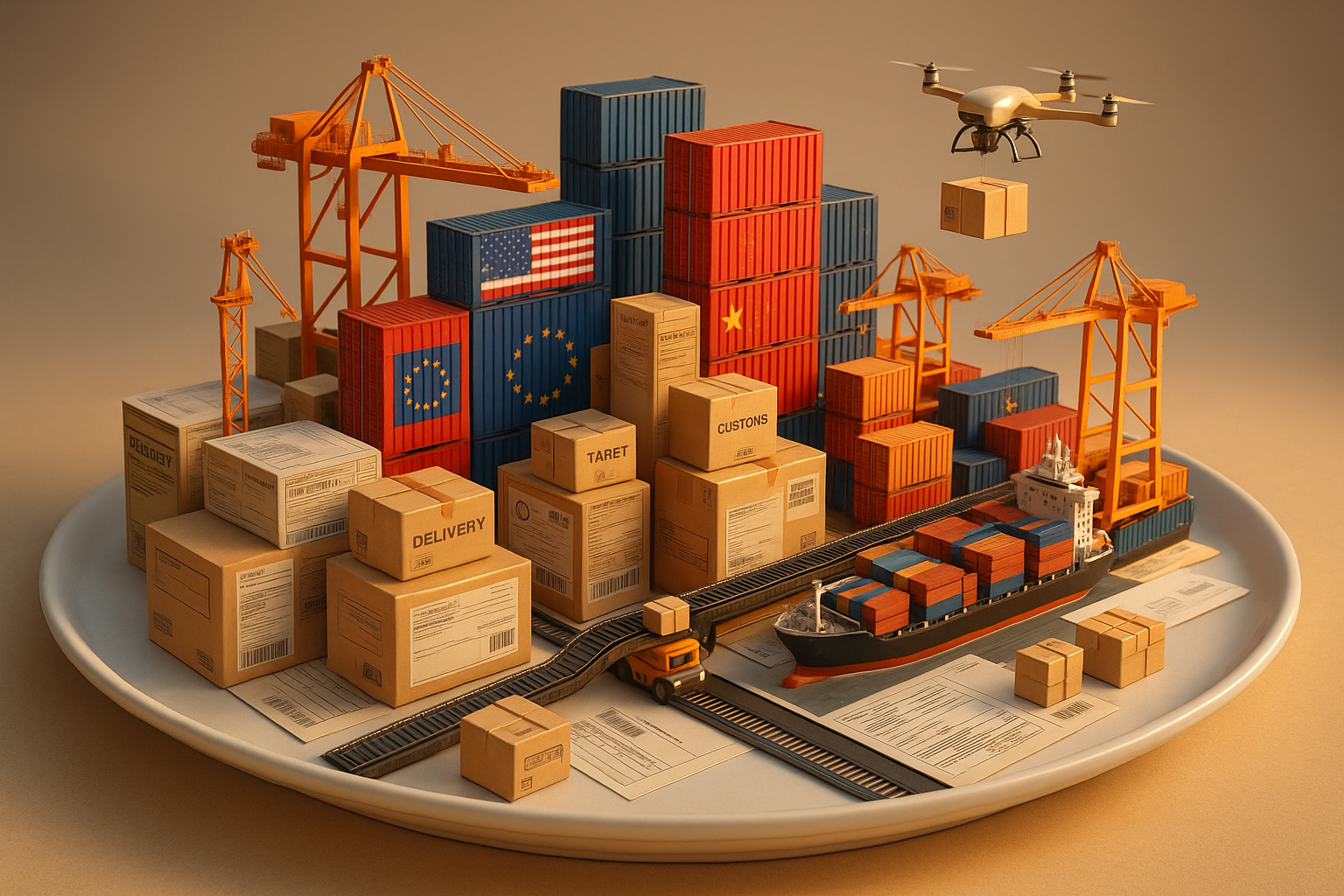Daily Cross-Border E-Commerce Briefing | August 8, 2025
1. U.S. Broad Tariff Hikes Take Effect (10%–50%); Partners Seek Concessions
-
The U.S. began collecting higher duties across dozens of trade partners on August 7, pushing the
average import duty to a multi-decade high.
Expect short-term volatility across FX rates, consumer sentiment, and ad auction
costs. Keep pricing modular (product + shipping + duties),
emphasize clear landed-cost transparency, and pivot budgets toward resilient
regions while avoiding high-duty HS codes during initial
dropship tests. Target phrases: “tariff playbook for Shopify stores,” “landed cost calculator
for DTC,” and “low-duty product research for dropshipping.”
Source: Reuters, Published on: August 7, 2025
2. U.S. Slaps Extra 25% Tariff on Indian Goods; Apparel and Petrochemicals Watch
-
An additional 25% duty on designated Indian imports will take effect 21 days after August 7.
Although the headline relates to oil-linked trade,
knock-on effects can reach textiles, synthetics, plastics, and packaging—categories
common in cross-border catalogs. Independent
sellers should monitor supplier quotations and fuel surcharge updates, rebalance ad
bids if contribution margins tighten, and
avoid high-duty HS codes during early product validation. For one-click dropshipping, prioritize
lightweight, low-duty SKUs with
transparent material disclosures to maintain conversion rates. Include clear messaging about taxes
and delivery windows on PDPs to preserve
trust. Long-tail keywords: “Indian tariff impact on ecommerce,” “synthetic fabric HS code
duties,” and “dropshipping pricing under new tariffs.”
Source: Reuters, Published on: August 7, 2025
3. Container Freight Update: Drewry WCI Signals Continued Volatility
-
Drewry’s World Container Index for August 7 indicates elevated spot rates with mixed week-over-week
moves across major lanes. Even if you ship mostly
small parcels, headhaul congestion can cascade into linehaul handoffs, transshipment, and
last-mile delays. Guard your ad promises by
posting realistic ETAs, enabling zone-based shipping, and adding PDP language like
“ships in X–Y business days; customs may extend delivery.”
Consider micro-batch testing via dropshipping to validate demand before bulk
commitments, and update returns/refund policies to reflect
potential carrier disruptions. SEO terms: “Drewry WCI weekly update,” “ocean freight impact on
small-parcel delivery,” and
“ETA messaging best practices for ecommerce.”
Source: Drewry, Published on: August 7, 2025
4. Google Ads Tightens EU Political Ad Rules; Compliance Signals Matter More
-
Google introduced stronger EU requirements—mandatory self-declarations and stricter limits on
political targeting. While most DTC catalogs are non-political,
review sensitivity often increases platform-wide. Reinforce merchant trust signals
such as return policy, shipping policy, legal imprint,
and verified business details to speed approvals. Keep creatives product-centric, steer clear of
social/political commentary in UGC, and ensure your
Google Merchant Center feed (titles, attributes, shipping/returns) is accurate to
minimize disapprovals. Target phrases:
“EU Google Ads political policy ecommerce,” “GMC policy compliance checklist,” and “ad
review best practices for Shopify stores.”
Source: PPC Land, Published on: August 8, 2025
5. Shopify Blows Past Q2 Estimates; AI Tools and Merchant GMV Drive Gains
-
Shopify topped Q2 expectations and issued upbeat guidance, lifting shares more than 20% and making
it the most valuable TSX listing.
The takeaway for independent sellers is ecosystem momentum: AI-assisted merchandising,
checkout enhancements, and partner apps
continue to improve conversion and LTV. If you run one-click dropshipping, double
down on low-inventory testing: launch more
SKU variants, lean on first-party data capture (email/SMS), and use post-purchase upsells to grow
AOV. SEO ideas:
“Shopify AI tools for product testing,” “Shopify checkout conversion optimization,” and
“dropshipping with Shopify Plus features.”
Source: Yahoo Finance, Published on: August 7, 2025
6. Klarna x WooCommerce: BNPL Expansion Targets Higher Conversions
-
Klarna’s expanded coverage for WooCommerce merchants brings broader BNPL availability across EU/US,
which can lift conversion rate and AOV
for seasonal or trend-driven catalogs. Disclose installment costs clearly at checkout, tighten
chargeback monitoring, and verify
fulfillment SLAs so that deferred-payment orders ship on time. This is especially potent for
dropship testing where low-MOQs allow
rapid iteration. Target phrases: “WooCommerce BNPL conversion uplift,” “Klarna dispute
management for DTC,” and
“BNPL checkout best practices for dropshippers.”
Source: Digital Transactions, Published on: August 7, 2025
7. Feedonomics Surface to Push AI-Enriched Product Data into Google Merchant Center
-
BigCommerce’s Feedonomics launched “Surface,” sending AI-enriched product attributes directly into
Google Merchant Center.
Higher-quality feeds—clean titles, granular attributes, policy-aligned shipping/returns—boost
visibility in Shopping and PMax while reducing account warnings.
For dropshipping catalogs with frequent SKU rotations, standardize variant fields
(materials, sizes, compliance) and keep shipping fields
honest to stabilize ROAS. Long-tail ideas: “AI product feed enrichment for PMax,” “GMC data
quality checklist,” and
“dropshipping feed optimization for Google Shopping.”
Source: Practical Ecommerce, Published on: August 7, 2025
8. China’s July Exports Beat Forecasts as Shippers Race Ahead of Tariff Deadlines
-
Exports rose 7.2% YoY and imports 4.1% in July as companies accelerated shipments before new tariff
windows. The short-term result can be
capacity tightness, port congestion, and sporadic customs backlogs. Align ad
scaling and promo calendars with freight windows,
use one-click dropshipping for low-risk pilots, and publish realistic ETA ranges on
PDPs to reduce WISMO tickets. SEO phrases:
“China export surge impact on ecommerce,” “aligning ad spend with freight capacity,” and
“dropship pre-order strategy during tariffs.”
Source: Reuters, Published on: August 7, 2025
9. IP Crackdown Continues: Brandy Melville Sues Temu for Trademark Infringement
-
Brandy Melville filed a lawsuit against Temu alleging trademark infringement and counterfeiting,
following earlier claims against Shein.
The case underscores sustained EU/US scrutiny of fast-fashion marketplaces and third-party sellers.
To protect ad accounts and payment gateways,
audit creatives for logo lookalikes, keep license/authorization records, and avoid
high-risk design overlaps—especially when
dropshipping directly from third-party factories. Long-tail terms: “ecommerce
trademark compliance checklist,” “UGC brand-safety for DTC,”
and “how to avoid IP violations in dropshipping.”
Source: Fashion Dive, Published on: August 7, 2025






